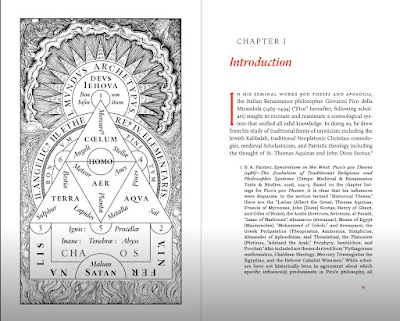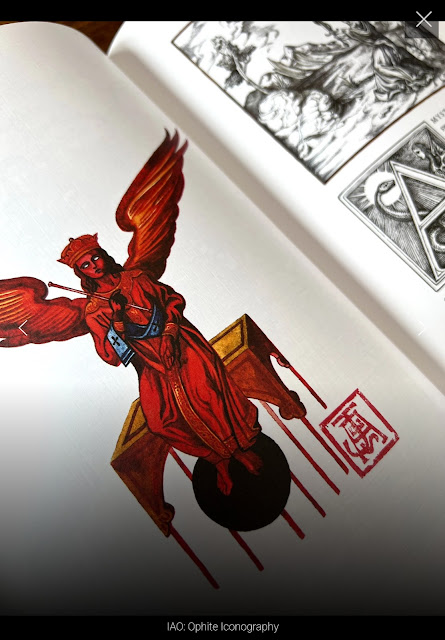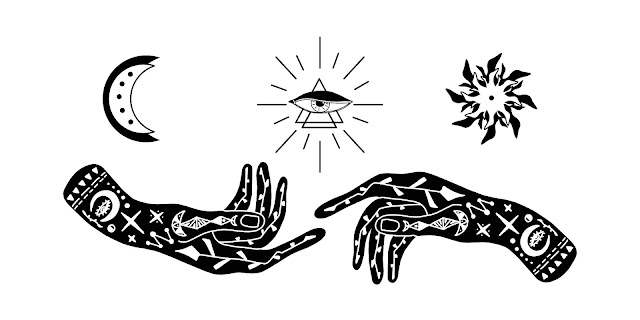EDGE OF THE CIRCLE BOOKS IS PROUD TO PRESENT THE FOLLOWING NEW TITLES--
FROM ANATHEMA PUBLISHING
CELESTIAL INTELLIGENCES
Angelology, Cabala, and Gnosis:
Giovanni Pico della Mirandola’s Quest for the Perennial Philosophy
By Greg Kaminsky
List Price: $81.50
Standard Edition Hardcover: STANDARD Edition (Limited to 721 copies):
5.25 x 8.5 inches. 176 pages. Hardbound 100pts, bound in Brown(ish) Shimmering 'Colibri' fine bookcloth. Metallic Black foil blocking on rounded spine and on the cover. Red Pantone + B&W interior, with Apple-Red with Burlap pattern embossing Endpapers. Dark Brown Headbands. Illustrated & Typeset by Joseph Uccello (Viatorium Press, 'Occlith' books series, etc.). Fine typography, printed on Cougar White Super-smooth 160M archive-quality paper.
FROM THE PUBLISHER:
The work of Renaissance philosopher Giovanni Pico della Mirandola is both significant and interesting for a number of reasons. First, his writings provide both an approach to, and an understanding of, ancient wisdom traditions (philosophical and religious systems) and the way that we receive them in modern times. This is partly a discovery of how Western society and culture honors these traditions, but tends to be fundamentally disconnected from them in the course of daily life.
Ultimately, this is a recognition that the esoteric traditions of the West are fragmentary at best, but also a realization that these fragments are our legacy and by working with them mindfully, we may still traverse a spiritual path that leads from delusion to wisdom. Second, studying Pico and his work reveals the manner in which a fundamentally Jewish esoteric doctrine and tradition –Kabbalah – was adapted and then adopted by Christian philosophers because it was a living, extant tradition and has a monotheistic character.
Through his writings, we can understand the way in which Western esotericism had been relegated to the dustbin of history before Pico so boldly plucked it from the trash heap to exalt it as it should be. He exposed the manner in which we could see that there exist equivalences and correspondences in various traditions and schools of thought. This can be understood as a sort of syncretism, but also a way to understand that, on some level, truth can be expressed in different ways that may be more accessible to different people in different places at different times. Pico also shows us how a fully extant, living esoteric system can be adapted and appropriated if one feels righteous in doing so. It was the deficiency in Western esotericism that there was no living system as all the ancient religions were dead and gone – except for Judaism. All that was required was the Spanish Inquisition to convert some Kabbalists and then exile them to Italy where they translated for and tutored Pico. From there it was no great task to adapt the once Jewish Kabbalah to a now Christian Cabala. This conversion made all subsequent esoteric practice in the West really flourish and one could say that Pico’s adaptation of the Cabala is the act that has had more influence on Western esoteric thought and practice for the following 500 years and counting than any other.
Lastly, Pico and his philosophy engages with angels and the orders of angels in unique ways to teach a system of thought and action – contemplation really – that is designed to lead to gnosis and/or theosis. The really beautiful thing about Pico’s system is that it perfectly mirrors all great mystical systems of the world in the specific methods that it employs. One of the things I really enjoyed was exploring how Pico’s explanation of how one goes from delusion to wisdom compared with Jewish Kabbalah, but there is ample territory to explore comparisons with many esoteric paths
**
PILLARS Volume 2, Issue 3:
A Wayfarer’s Hearth
Stories of holy pilgrimages, transformative journeys and revelatory voyages
Edited by Gabriel McCaughry & Evan Davies
CONTRIBUTORS: Aaron Cheak (PhD), Aleco Julius, Brian Cotnoir, Carl Abrahamsson, Carl Austin Hyatt, Darragh Mason, Dr. Dearthrice DeWitt, Evan Davies, Gabriel McCaughry, Gloria D.N.E., Gavin Fox, Humberto Maggi, Ian C. Edwards (PhD), Johnny Decker Miller, Johana Reuter, Jennifer Chiasson, Jack Grayle, Kazim, Kim Schwenk, Matthew Olmsted, Orryelle Defenestrate-Bascule, Philipp Müller, Rosemary Stehlik, Ross Fleming, Shani Oates, Suzanne Read, Tasha Menary, Viktoria Polikarpova (28 contributors!)
List Price: $83.95
Standard Edition Hardcover
STANDARD Edition (Limited to approx. 700 copies — 2021): 6.5 x 9.5 inches. 264 pages. Hardbound 90pts, Fine 'Canapetta' Italian bookcloth, matte brown foil stamp designs on rounded spine and on the cover; blind deboss on the cover and on the back cover; full colour interior, and 'Maroon' ‘Handspun texture finish’ endpapers. Dark Brown Headbands. Cover illustration by artist Ross Fleming (Hens Tongue). Fine typography; illustrated thoroughly by various artists; printed on Cougar Natural 160M archive-quality paper. Hand-numbered individually.
FROM THE PUBLISHER:
Vol.2, Issue.3
Stories of holy pilgrimages, transformative journeys & revelatory voyages
The night is long, and we are in no hurry. This is a time for reflection, to think back on where you have been – and where it has led you to.
Whether you have crossed oceans or deserts, wound your way through labyrinthine cities or long-forgotten ghost towns, followed untrodden paths or the pilgrim’s well-worn way – you are no longer the same, and you have wisdom to share.
This is the Wayfarer’s Hearth: a gathering of voices and a recollection of transformative spiritual journeys.
+ + + + +
These are the reminiscences, lessons learned, and personal accounts we sought for the next edition of PILLARS.
For those who have been deeply affected in esoteric ways by our travels to other lands, who have had our perceptions altered through cultural immersion, through being confronted with our own fears and prejudices. For those who have had our eyes pried open, our inner-selves irreversibly changed.
For our next collection, we sought stories of wandering, initiation, and of inner alchemical transmutation. We wanted to hear from those who have travelled far in search of a teacher, or who have been surprised by an unexpected revelation while abroad.
Today, however, travel is not a reality for many of us. The pandemic has suddenly made our lives much smaller in terms of where we can physically be, and so many of us turn to our bookshelves instead. Our imaginations become vessels, ferrying us away to distant shores where new gods, truths, philosophies, religious precepts, and histories await.
Both of these important aspects are explored within this brand new issue of PILLARS!
**
IAO:
Ophite Iconography
By José Gabriel Alegría Sabogal
List Price $94.95
Standard Edition Hardcover
STANDARD Edition (Limited to 913 copies — 2022): 6.5 x 9.5 inches. 224 pages. (The dimensions of a PILLARS book but thicker.) Hardbound 100pts. Cover Material: 'Paradise' Black & Green Fine Italian Bookcloth. Gold foil blocking on rounded spine and on the cover. Full Colour interior, with B&W printed Graphite Endpapers with cracked-stone texture. Green & Yellow Headbands. Illustrated throughout by José Gabriel Alegria Sabogal. Fine typography, printed on textured paper: Strathmore Cambric Platinum White 200M archive-quality paper. Individually hand-numbered.
FROM THE PUBLISHER:
IAO is an iconographic proposal, an attempt to illustrate the Gnostic worldview and its myths as understood by the Ophites, a sect of which little is known. It is, perhaps, an exercise of imagination, of what Christian iconography could have resembled if the Ophites had survived. Visually, it follows the sequences of the Speculum Humanae Salvationis and the Biblia Pauperum, reordering their contents according to this heterodox initiative.
“These images are, in fact, visions, allegories, and myths of a yet unexplored richness. And the ambitious proposal here is to consolidate an iconographic programme…”
Central to this initiative is the reconstruction of the Ophite diagram described by Origen of Alexandria in Contra Celsum – a complex system in which their whole cosmic vision was integrated.
“The three axis, which the images will revolve around, are three distinctive topics of the gnostic worldview: The demiurge (and his relation to the manifested world), the myth of Sophia (and the female aspects of the divine), and the ophite Christology, or the saviour as a serpent.”
IAO rejects the commonly held notion of Gnosticism as a mere form of dualism within Christianity, and explores its relationship with other religions – if only by conceptual coincidence, following Edward Conze’s comparison between Buddhism and Gnosis.
Moreover, the Ophites, by declaring Christ to be an incarnation of the Serpent of Genesis, stood outside the moral spectrum of what is now understood as Christianity. Instead, notions of non-duality can be found in the doctrines of Basilides and the idea of the Pleroma, which are explored within, both conceptually and visually.
CONTENTS:
- Introduction
- The World as Reflection
- Sophianic Figures
- The Image of the Pleroma
- Appendix. Sibylline Dialogues: An Imaginary Conversation with William Blake
- Transcription & Translation of the Sibylline Dialogues
- Bibliography
**
KURUKULLA: Goddess of Bewitchment
A Devotional Path to the Red Enchantress of Uddiyana
By Verónica Rivas
List Price: $81.50
Standard Edition Hardcover
STANDARD Edition (Limited to 723 copies — 2021):
5.25 x 8.5 inches. 192 pages. Hardbound 90pts, bound in 'Saffron Sunshine' duo-coloured Bamberger Kaliko fine bookcloth. White foil blocking on rounded spine and on the cover. Full Colour interior, with Marbled 'Tigereye' Endpapers. Illustrated throughout by Andrey Savchenko. Fine typography, printed on Cougar White 160M archive-quality paper. Individually hand-numbered.
FROM THE PUBLISHER:
In Kurukulla: Goddess of Bewitchment – A Devotional Path to the Red Enchantress of Uddiyana, author Verónica Rivas combines academic research with personal experience to offer a theoretical-practical study of Kurukulla, the goddess in Hinduism related to desire, lust, magic, and witchcraft.
Many of these aspects were left aside, however, as her importance and popularity within Tantric Buddhism continued to grow. In Kurukulla, we have a goddess of tribal origins, initially venerated as a protector by various nomadic clans who related her to fertility and material affairs, yet also considered her dangerous and fearsome. Progressively, the goddess was incorporated into the Buddhist pantheon, and during this process, Kurukulla acquired different roles and lost others. Many practices were developed related to issues such as protection against animals and certain diseases, obtaining influential positions in society, love affairs, and even getting rid of one’s enemies.
Kurukulla: Goddess of Bewitchment offers a tantric perspective on a deity considered the goddess of eroticism, the mistress of enchantments and bewitchment, who uses desire as a weapon for transcendence. Practicing with Kurukulla allows us to reach our true nature by making our daily life, our fears and weaknesses, the very source of liberation.
The goddess of the red body represents the pure manifestation of intrinsic wisdom, the primordial energy that nourishes all realms of existence, as well as life and death as complementary opposites.
The rituals and devotionals presented in this book are intended to openly and freely establish a deep connection with the deity. They are shared in a simple and understandable way that will allow practitioners to integrate them into their life easily and completely.
**





















Comments